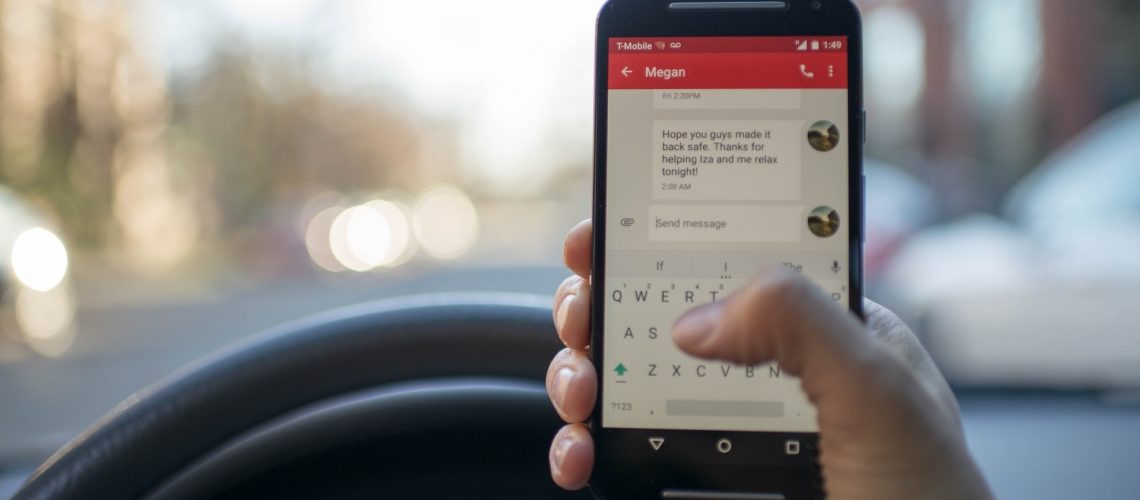Update: Major Loophole Plugged in State’s Hands Free Cellphone Laws
Assembly Bill 1785 is a groundbreaking new law that took effect January 1, 2017. It states “holding and operating a handheld wireless telephone or an electronic wireless communications device unless the wireless telephone or electronic wireless communications device is specifically designed and configured to allow voice-operated and hands-free operation, and it is used in that manner while driving.” It prohibits motorists from holding their phone while driving, and drivers may only perform the motion of a single swipe or tap of a device while it is mounted in a vehicle.
Safety officials are hoping AB 1785 will plug a major loophole in the state’s original hands-free cellphone laws. While it is already illegal for drivers to call or text without a hands-free device, the law was silent on features that were not in wide use on cell phones when the original measures were passed by the legislature more than eight years ago. This includes checking and updating their social media profiles, navigation apps, scrolling through music playlists, and taking photos or videos.
“This bill targets the deadliest cause of distracted driving related crashes, the use of an electronic device while driving,” Assembly member Bill Quirk, the author of AB 1785, said of his bill. A California Office of Traffic Safety study this year determined that 1 out of 8 drivers on the road are paying as much attention to his or her smartphone as to the road. State road safety officials estimate that some form of distracted driving is a factor in 80 percent of crashes.
Original Story: Cellphone Use While Driving
People of all ages move from place-to-place looking at smartphones, checking apps, maps, music, email, texting, speaking; it’s a common sight to see people looking at their phones while sitting at red lights. Police officers are trained to check immediately for cellphone use at the scene of accidents as texting has become a common driving distraction; and the dangers from distracted driving are real.
Cars & Cellphones: Where Do You Draw the Lines?
Most Californians know by now: it’s against the law to talk on a handheld phone while driving. It is easy to know that you’re in compliance with the law if you have two hands on the wheel. As technologies become more and more sophisticated, touchscreens on your dashboard access not only radio and sound systems and music libraries, but also internet, text and written and dictated emails. While Siri and other helpers have made it possible to communicate with two hands on the wheel, the violations unfortunately are too frequent, and the consequences too often serious and tragic.
Because people reach for their cellphones while driving, it is important to know the scope and limitations of the rule against cellphone use. We know technology is moving faster than the law—what about touchscreens that operate a cellphone like tuning a radio? What about holding a phone in speaker mode? What can you do and what can you not do?
The ‘Talking While Driving’ Rule and it’s Exceptions
California Vehicle Code §23123 specifically states that a “person shall not drive a motor vehicle while using a wireless telephone unless that telephone is specifically designed and configured to allow hands-free listening and talking, and is used in that manner while driving.” Exceptions to the “talking while driving” rule provided in this statute include making an emergency call or driving on private property. Other exceptions apply to emergency service professionals using a phone while driving an emergency vehicle.
Texting While Driving Laws
California Vehicle Code §23123.5 was very specific in prohibiting the use of a cellphone while driving “to write, send, or read a text-based communication, unless the electronic wireless communications device is specifically designed and configured to allow voice-operated and hands-free operation to dictate, send, or listen to a text-based communication…” A “text-based” communication is defined by the statute as “including, but not limited to, communications referred to as a text message, instant message, or electronic mail.” Sending an email or updating your Facebook status is a violation. Dictating a text or email is not.
This statute seemed sufficient when it was enacted in 2006, the bygone era of the RAZR and “flip” phones. Smartphones, however, are mobile, hand-held computers capable of extraordinary interactions, far beyond what legislators were thinking about when they banned speaking through a hand-held phone. We know you cannot text or talk with a phone in your hand, but what about using a GPS application? A music app? Watching a ballgame? Touching a screen that does dozens of things?
Progression of Technology and the Laws
In People v. Spriggs (2014), 224 Cal. App. 4th 150, the Court of Appeal reviewed the case of a driver cited for using his phone’s GPS application while in heavy traffic. The DA argued that the driver clearly violated the statute by using a handheld device while driving. The danger of distracted driving, he argued, was as real as looking at a map as holding a phone. The trial court agreed and fined the driver for violating California Vehicle Code §23123. But the Court of Appeal reversed, stating that California Vehicle Code §23123, only prevented drivers from engaging in conversation while driving unless the phone was used in a hands-free manner. The Legislature, the Court held, was not even thinking about maps or navigation aids at the time. So they couldn’t have intended to preclude uses they never imagined.
The key phrase in the statute upon which the Court of Appeal relied, was “hands-free listening and talking.” In response to the District Attorney’s argument that the statutory language prohibits any use of a hand-held phone while driving, the Court of Appeal disagreed and held that the statute did not prohibit any use of the phone. Looking at the display, holding “the phone in one’s hand, even if configured for hands-free listening and talking,” looking at the time or merely moving the phone “for use as a paperweight,” were not prohibited. It was not a violation of the Code to look at a map on one’s phone. These things might be distracted driving, and dangerous, but not by themselves illegal.
Based on the ruling in People v. Spriggs, drivers may check their GPS and talk on the phone while driving, even if the phone is in-hand, so long as the phone is set to “speaker mode.” Since 2006, mobile apps are everywhere—some even to help drivers – Google Maps and Waze to name a few – and unless and until changes are made to the statute, People v. Spriggs will stand for the proposition that all cellphone use, even hand-held, is not prohibited.
Keep your eyes on the road and two hands on the wheel and you should have no problem. Look down with your hands in your lap, and that can be probable cause for a police stop. See People v. Corrales (2013), 213 Cal. App. 4th 696 (even though the officer never saw the cellphone in Defendant’s hands, the officer saw the Defendant repeatedly looking down at his hands and making movements with his hands which the officer reasonably believed were associated with text-messaging).
Keep Your Eyes on the Road
The takeaway? Violate the law, get into an automobile, truck, or motorcycle accident, and you may not only face criminal prosecution, but possibly civil and perhaps even punitive damages as well. The moral of the story: Keep your phones on speaker and your eyes on the road.
The Help of an Experienced Attorney is Key to Presenting Your Case
The Boesch Law Group has seen this issue from all sides—defending those accused of distracted driving, and litigating civil claims against cellphone users who cause auto accidents.
DISCLAIMER: The materials on this website are for general information purposes only and should not be construed as legal advice, legal opinion or any other advice on any specific acts or circumstances. Readers should not act or refrain from acting upon this information without seeking professional advice.
Transmission of information on or by use of this website is not intended to create, and receipt does not constitute, a lawyer-client relationship between the sender and receiver. Such communications will not be treated as confidential. Photographs and other graphics may be for dramatization purposes only and may include models. Likenesses do not necessarily imply current client, partnership or employee status.

